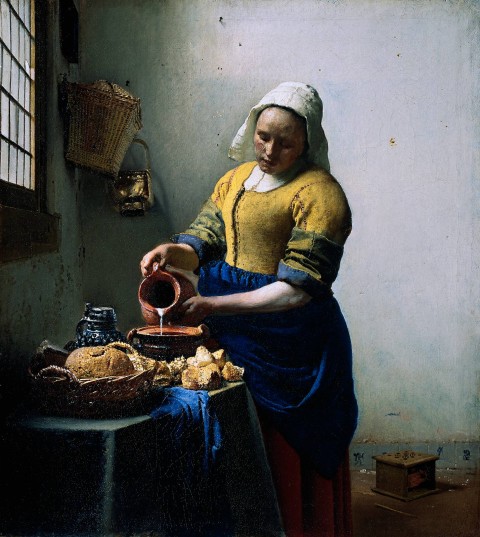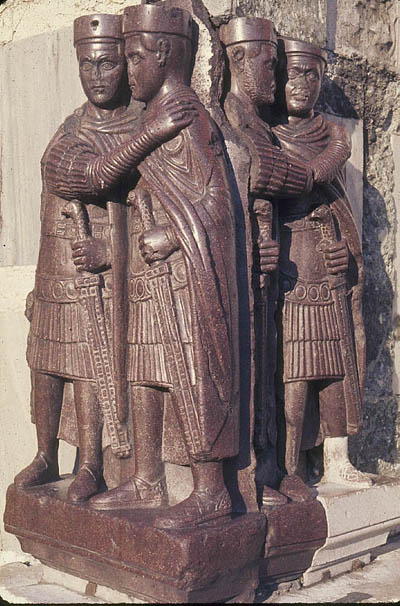Thursday, January 3rd, 2013
Expensive Pigments, Dyes and Artistic Mediums
Lately I’ve been thinking about some of the artistic mediums and/or colors which were expensive or highly prized at different points in history. Obviously, there are some artistic mediums which were valued in the past that still have value today, like gold or silver. There are a few other mediums have stuck out to me beyond these common examples, and I thought I would jot down a few things about these mediums and colors.

Cult Image of the God Ptah, lapis lazuli, ca. 945-600 BC (Dynasty 22 – early Dynasty 26). Height 2.25″ (5.6 cm), Metropolitan Museum of Art
LAPIS LAZULI: Lapis lazuli is a hard stone which contains the mineral lazurite. This rare blue stone which originally came from Afghanistan and was highly prized in the ancient period. In fact, in early cultures lapis lazuli was considered more expensive than gold. Due to its expensive nature, lapis lazuli was usually used in royal sculptural workshops, either for depictions of royalty or depictions of the gods.1 Such is the case with the cult image of the God Ptah, the Lord of the Sky. The lapis lazuli is creatively used in this instance to underscore Ptah’s role, since the medium suggests a deep blue cosmos studded with stars.
PORPHYRY (AND THE COLOR PURPLE): The color purple was highly prized in ancient cultures, particularly Roman, Byzantine, and medieval cultures. This color was largely prized because of the dye Tyrian purple, which is also known as “royal purple” or “imperial purple.” Tyrian purple dye was rare and valued, since it was made from the secretion of mollusks.2 During ancient times only the elite could afford to be clothed in purple. As a result, the color purple is associated with the iconography for royalty and deities.3 Such imagery can be found in representations of Christ (like mosaics found at Sant’Apollinare Nuovo) and emperors (like the Justinian mosaic in San Vitale). Even the Virgin Mary is sometimes associated with purple.
As a result of this expensive dye and its associations with the elite, other purple-colored substances, like the hard stone porphyry (see image above), were also valued. The red-purple variant of porphyry which was valued among royals came from a specific remote site in Egypt: Gebel Dokhan. Even today, this is the only location in the world in which imperial porphyry is found.

Vermeer. “Woman Pouring Milk” (The Kitchen Maid), c. 1660. Oil on canvas, which includes ultramarine blue pigment
ULTRAMARINE BLUE: Ultramarine blue is a pigment which existed in ancient times, but was also used in the Early Modern period. This pigment was highly valued, largely because true ultramarine blue is created with ground lapis lazuli stone. The ground stone is purified with multiple washings and then bonded with oil using a hand mulling process. Since the early nineteenth century, however, ultramarine blue is only created through a synthetic process.
Renaissance and Baroque artists, including Vermeer (see image above) used true ultramarine blue. The vibrant blue of the kitchen maid’s wrap is a great example of the brilliant color found in this type of pigment. True ultramarine was expensive, and sometimes Renaissance artists would resort to using azurite blue instead.
Okay, now it’s your turn. What are some other artistic mediums or pigments which which were valued in history? (Off the top of my head, I can think of other fabrics which have been valued, like silk and velvet.) If you know of specific works of art which are created with certain valued mediums or pigments, please share!
*Several of my thoughts for this post were sparked by the website, “Pigments through the Ages.” This website has a lot of information about the history of different pigments, how to make these pigments, and the technical details for these pigments.
1 Blue was a very important color in Ancient Egypt. In addition to the lapis lazuli stone, the Egyptian blue pigment was also used for painting depictions of royalty and gods.
2 Victoria Finlay explains that 250,000 “murex branders” and “murex trunculus” shellfish were needed to extract the dye needed for one garment (which would be about half an ounce. Additionally, Finlay explains that the clothes dyed in purple had a distinctive odor of fish and the sea, which Pliny disliked and called “offensive.” See Victoria Finlay, The Brilliant History of Color in Art (Los Angeles, The J. Paul Getty Museum, 2014), p. 28.
3 A mythology surrounding the discovery of purple dye developed in ancient cultures. The Roman writer Cassidorus explained that Tyrian Hercules discovered the purple color when his dog devoured a murex snail while they were at a beach. Later artists were also interested in this mythology; the Baroque artist Rubens painted “Hercules and the Discovery of the Secret of Purple” (La découverte de la pourpre”) around 1636.

In his book ‘Seeing Medieval Art’, Herbert Kessler starts off with a focus on the meaning and significance of the materials used in religious images, sculptures and objects. He makes a fun claim that stained glass windows were “the most original and important medium of the high Middle Ages”. Combining color, skill and light, it is interesting that stained glass has fallen out of favor while gold must set the record for longest and most widely appreciated material.
i love learning about this topic, M! i (mostly) enjoyed this book and was especially interested in the crushed cochineal bugs that created such a blood red color. the writing wasn’t incredible (and it’s more of a travelogue than anything else), but if you’re associated with the arts in any way, it will keep your interest!
http://www.amazon.com/Color-A-Natural-History-Palette/dp/0812971426/ref=sr_1_1?ie=UTF8&qid=1357327989&sr=8-1&keywords=history+of+color
An obvious recent example is Hirst’s “For the Love of God,” the raw materials (mostly diamonds and platinum) for which supposedly cost 14 million pounds. Reports vary as to how much it sold for or, indeed, whether it’s been sold at all. But Hirst’s stress on the cost of the raw materials has raised the question of how much his own association with the object is worth, or might be worth.
See, for example: http://www.guardian.co.uk/artanddesign/video/2012/apr/18/damien-hirst-tate-modern-skull-video
And: http://en.wikipedia.org/wiki/For_the_Love_of_God
Another interesting (and notorious) recent-ish example is Piero Manzoni’s “Merda d’artista”–not because it’s made from expensive materials (quite the opposite!) but because the artist originally pegged the cost of his cans to the current market price for gold.
Ben
Cinnabar vermilion/mercury was an extremely expensive and symbolically important pigment/mineral, since red was a royal and religious colour in many civilizations and cultures, until it was manufactured synthetically on an industrial scale.
Intriguing post as always M! I am curious as to how this topic can be related differently by various authors. In this instance, the substances and colours are being related with a sense of their symbolic and financial value. This is an important consideration when considering the techniques and media artists used to create certain effects that would please their patrons.
There is also the consideration that artists (particularly of the Renassaince and Baroque) and those they employed to create their pigments were equally what we would today regard as “chemists” or manufacturers. Reading the technical reports that look at pigment samples from paintings, the details revealed about their ingredients – such as crushed glass, lead, clay, tin, calcium sulfate etc seem equally as important as understanding the symbolic intention behind pigments and their uses. Certainly neither would be able to exist without the other!
Hence, for those interested, I would like to suggest a valuable resource that takes this discussion into the technical realm, as well as revealing how past practitioners would achieve these colours: the book is “The Pigment Compendium: Optical Microscopy of Historical Pigments” By Dr Nicholas Eastaugh : an extended preview being available at Google Books:
Cheers
H
Thanks for the comments, everyone!
@cf: Your comment has made me wonder about the financial expense to create stained glass. I’m going to have to research that point further! I wonder if certain colors were more expensive to produce in glass than over colors. I like Kessler’s claim, though. I can see his point about how stained glass was the most important medium of its time.
@Joolee: That book looks so fascinating! I’ve put it on my Wish List. Thanks for the recommendation! I’m curious to see what the book says about crushed cochineal bugs. 😉
@Ben: How could I forget Damien Hirst? His diamond-encrusted skull is such a great example of art and expensive materials. I hadn’t heard of “Merda d’artista” before your comment, but it reminds me quite a bit of Warhol’s oxidation paintings (his “Piss Paintings” series). It seems like both artists wanted to make ironic commentaries about how they, as artists (and their bodies!), are inherently expensive.
@Bogdan: I’m glad that you said something about vermillion. I actually had heard that this pigment was expensive and originally tried to find some information for this post, but I couldn’t come up with much. Thanks for filling in some details. Based on what I found on the “vermillion” entry for Pigments through the Ages, I’m guessing that the toxicity of mercury made this pigment so rare and expensive.
@H Niyazi: Thanks for the Google Books link! I can think of some friends who might be interested in this book. I can see how some would argue that artists were “chemists” of their day. It’s easy to think of such crossover during the Renaissance period, especially with Renaissance men like Leonardo da Vinci (who liked to experiment with different binding agents, as evidenced in his “Last Supper”).
Last year the BBC broadcast the History of Art in Three Colours, a three part series by James Fox.
http://www.bbc.co.uk/programmes/b01l9mf8/episodes/guide
I wasn’t entirely persuaded that gold was a colour rather than a material but it provided some interesting insights nevertheless.
Hi Anne! Thanks for this link. This series on color sounds fascinating! I’ll be sure to look into it.
1. (Clothing, Personal Arts & Crafts / Dyeing) a blue pigment consisting of sodium and aluminium silicates and some sodium sulphide, obtained by powdering natural lapis lazuli or made synthetically: used in paints, printing ink, plastics, etc.
Hi Geraldine! I assume that this is the definition for ultramarine blue? Thanks for including information about the chemical breakdown of the pigment. It’s nice to have a better idea of how it has been synthetically manufactured since the 19th century. As far as I am aware, ultramarine blue is not manufactured with natural lapis lazuli anymore (but if anyone who reads this blog knows otherwise, please share!).